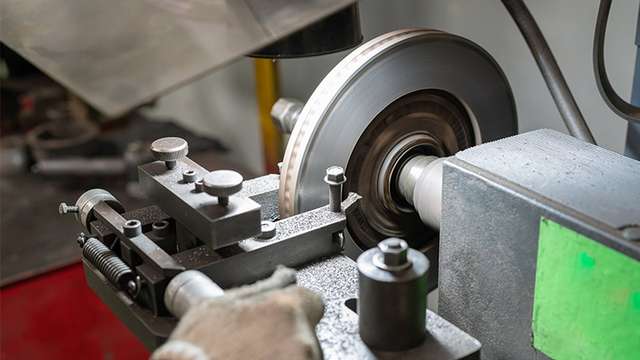- brakes
Brake Disc Machining or Brake Disc Replacement - which one is better?

Updated 4 Oct 2019
Joel Ilton

Everybody knows that the braking system is one of the most important safety systems on their vehicle and that over time, the brake pads will wear out and require replacing - but one of the most common questions when it comes to brake servicing is whether to replace the disc rotors, or carry out disc machining. This is also known as brake disc resurfacing.
The brake discs, also known as rotors, are the circular metallic components that are located behind your wheels. When you put your foot on the brake pedal, the brake fluid acts on the brake pads inside the caliper, and they are forced against the rotor, which slows the vehicle.
As both the brake pads and discs are in constant contact, the discs will wear down, often unevenly, and this can cause a number of issues, such as the vehicle pulling in one direction when slowing down, or a vibration through the body of the vehicle. This is known as brake shudder and either replacing the discs or carrying out machining is the only way to rectify this problem.
Replacing the disc rotors is a simple process of removing the old and fitting the new, whereas disc machining is a bit more involved. The brake discs that require machining are first removed from the vehicle and placed on a lathe. A special set of cutting implements are then adjusted to remove the minimum amount of material from the face of the discs, providing a fresh surface for the brake pads to run against.
So, should you have your brake discs machined, or is replacement the best option when carrying out brake servicing? This comes down to the type of vehicle you drive, the operating conditions and the amount of wear on the discs.
All brake discs are manufactured with a minimum thickness rating. Once the disc rotors have worn down past this measurement, they must be replaced to ensure correct braking operation. In Australia, having a vehicle with brake discs that measure under their minimum thickness makes the vehicle unroadworthy.
Before looking at machining brake discs, the mechanic must measure the thickness of the brake disc and compare it to the minimum thickness - if it is above this measurement and will not go under this measurement within the replacement brake pads service life, the brake discs are safe to be machined. If the minimum thickness will be exceeded, either during the machining process or within the replacement brake pads service life, they must be replaced with new discs.
If you drive a European vehicle, the brake discs and pads are usually replaced at the same time. These brake discs are of a ‘sacrificial’ design, meaning they will reach their minimum thickness during the brake pads service life, and failure to replace them when carrying out a brake pad replacement will negatively affect the braking performance of the vehicle, as well as rendering the vehicle unroadworthy.
One of the upsides of having your brake discs machined instead of replaced is the cost-saving. Machining the brake discs is often half the cost of replacement rotors, although it may take more time for your vehicle to be serviced if you opt for machining instead of replacement, as machining requires more labour time to complete.
Not sure if you need to have your brake discs machined or replaced? That’s where AutoGuru comes in! Simply book a brake pad replacement or braking system inspection with one of our 1700 local workshops, and they will best advise you on any repairs or replacement that’s needed. Too Easy!

Written By
Joel Ilton
Finding a passion for cars from a young age, Joel carried out work experience as a mechanic whilst at school before starting an apprenticeship after finishing year 12.
Joel is now the Workshop Manager at Robina Volkswagen.